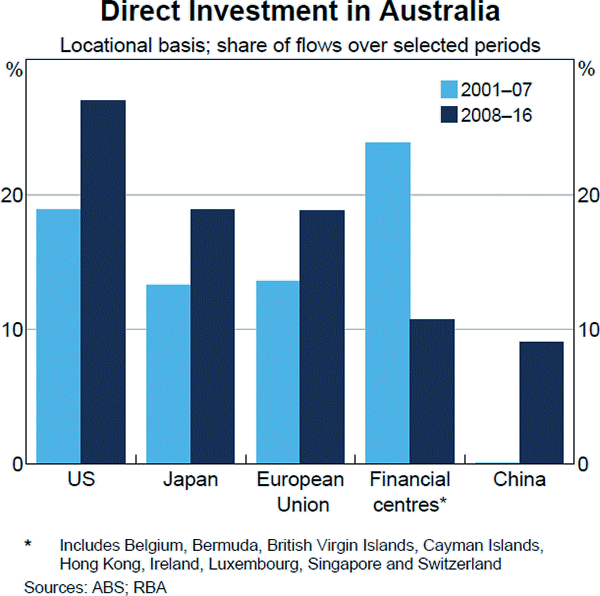Statement on Monetary Policy – November 2017 Box B: Chinese Direct Investment in Australia
The Chinese authorities tightened their enforcement of capital controls in late 2016, partly in response to a marked increase in the pace of Chinese direct investment abroad over 2015 and 2016. Among other things, the authorities established formal guidelines for investment overseas, putting in place restrictions on investment in sectors such as real estate, entertainment and tourism, but encouraging it in others such as mining and infrastructure. In addition, direct investments are likely to come under increased scrutiny if they have not undergone due diligence, are highly leveraged and/or are not aligned with investors' core competencies. Chinese investment overall currently accounts for a relatively modest share of total foreign direct investment flows (FDI) into Australia. Moreover, FDI accounts for only a third of total capital flows into Australia (portfolio flows make up the largest share). In any case, this change in Chinese policy has occurred at a time when overall capital inflows to Australia have been noticeably lower than in the past, in line with lower current account deficits following the end of the mining investment boom.
Looking back at history, direct investment flows from China to Australia have been larger since 2008 than they were over the preceding decade. (Investments are considered to be ‘direct’ if an investor gains control or a significant degree of influence on the management of an Australian company.[1]) The increase in FDI from China to Australia occurred amid a substantial increase in direct investment flowing out of China more generally over the past decade as the Chinese authorities gradually opened up the capital account. Chinese investment in Australia made a contribution to the expansion of Australia's productive capacity during the mining investment boom in particular, attracted by the favourable risk-adjusted returns on offer here.
The source of FDI flows to Australia can be difficult to measure. There are two main ways to do so. First, FDI can be recorded based on the location of the immediate investor (‘locational’ basis). Second, FDI flows can be measured according to the economy from which they were ultimately sourced (‘ultimate risk’ basis), regardless of whether the investment flowed through an offshore financial centre before arriving in Australia. In the case of Chinese investment in Australia, this distinction is important. Australia has received around US$35 billion in direct investment flows from mainland China over the past decade when measured using the location of the investor. Estimates based on the ultimate source of FDI flows suggest that Australia received more than double that amount. To a large extent, this difference is because a sizeable amount of Chinese investment is directed to Australia via Hong Kong and other financial centres. Another reason for the difference is that the locational measure is net of investment flows back to the direct investor.
According to measures based on the location of the investor, China's share of overall FDI flows into Australia has averaged just under 10 per cent since 2008, compared with almost zero in the preceding period for which data are available (Graph B1). The share is somewhat higher when measured based on the ultimate source of FDI. Despite the considerable increase in China's inflows, China's share of the FDI stock in Australia is smaller than the shares of other major economies. The largest direct investors in Australia have been from the United States, Europe and Japan. According to measures based on the location of the investor, these economies have accounted for around 60 per cent of the flow of FDI into Australia since 2008, and currently account for a little over half of the outstanding stock of FDI in Australia. In contrast, China accounts for only 5 per cent of the outstanding stock of FDI in Australia based on the location of the investor.

The majority of investment in Australia from China has been in the metals and minerals sector. This was particularly the case during the mining investment boom, when Chinese investment played a role in expanding the sector's productive capacity to meet growing demand for Australia's natural resources (Graph B2). Since then, however, a range of measures suggest some easing in the pace of direct investment flows from China to Australia. This was accompanied by a shift in Chinese investment towards a broader range of sectors in Australia, particularly towards large-scale real estate and infrastructure projects, and a shift away from state-owned (or partly owned) corporations towards the private sector. One measure, from a global database that captures investments above US$100 million, indicates that large-scale real estate and infrastructure projects accounted for roughly two-fifths of total Chinese direct investment in Australia from 2014 to 2016 (a similar database with a smaller threshold suggests a slightly larger share).[2] Although the entertainment and tourism sectors have received a larger share of FDI flows out of China in more recent years, Chinese investment in Australia has tended to be less concentrated in these now-restricted sectors relative to Chinese investment in many other countries. For example, in recent years close to 30 per cent of total Chinese direct investment to the United States has been to the entertainment and tourism sectors, compared with around 5 per cent for Australia (though such estimates only capture large investments).

Footnotes
This usually arises through owning at least 10 per cent or more of a company's equity. Foreign investment in real estate is considered a form of direct equity investment and comprises a small share of total direct investment inflows to Australia. [1]
KPMG and the University of Sydney (2017), ‘Demystifying Chinese Investment in Australia’, May. [2]